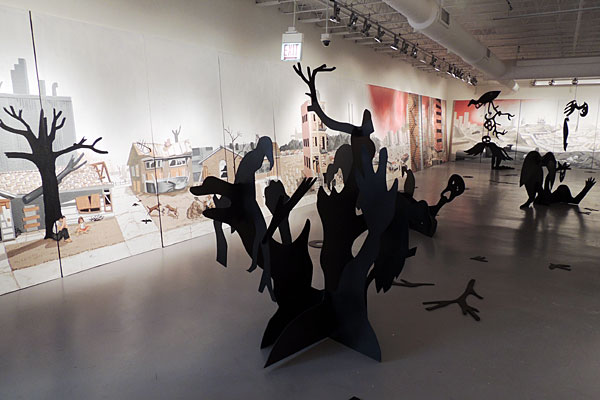
Panoramic paintings are an early form of virtual reality entertainment. The practice of immersing a viewer inside a room-sized painting dates back more than two centuries. Now, in the upper-level gallery of the Hyde Park Art Center, a new kind of panoramic painting is on display. Tom Torluemke’s Fearsome Fable—Tolerable Truth lines the walls with reversible painted panels. One side depicts a utopia of plentiful nature and human happiness. On the reverse, it’s all doom and gloom. Viewers are invited to touch the art, turn the panels, and choose their own adventure. I recently caught up with the artist to ask him about this ambitious project.
What has been the reaction so far to your participatory murals?
The reaction is a bit of shock and awe. The biggest surprise for the people viewing it is right after they ask me the question, “How long did it take you to do it?” they realize there is a whole other side to the painting. Sixty percent are attracted to the grey side, dystopia. Forty percent are attracted to the positive side, the utopia.
Do the scenes depict a specific place?
The scenes were developed from my imagination, like the ocean drained of water, and from memory, like the oil refinery in Whiting, Indiana. There are vignettes tied to true to life experiences. Some of the characters are real people. There is a character of a man that’s digging his own grave. He is the likeness of Thomas Hart Benton [a regionalist mural painter]. That came from his autobiography I read. He was such an outspoken man that lots of people turned their backs on or just didn’t like him period.
Is humankind doomed?
I’m very optimistic, so I’d like to think not. However, some things do worry me, and one of them is peoples’ priorities. They seem to revolve mostly around money and work. Here in the United States, everything has a price, a human being, an arm, a leg, health, a tragedy, et cetera. Work is so intensely woven into peoples’ identity in this modern age, and we seem to have invented so many mechanical, robotic and electronic tools that we’ve become near obsolete. There may not be enough jobs available for people to do. So, I think a big future issue to be discussed is the category of work versus money and what do human beings do if that whole structure has to change. In many instances, we put work and money first, instead of, let’s say, quality of character, empathy, or virtue. I think a lot of excellent choices would be made if we started to put our advertising dollars toward some of these virtuous characteristics. Now, I’m not saying that I’m innocent in any of this. I catch myself on a daily basis doing things I’m not supposed to do, but I think if there was a big movement toward more ethical behavior, I would think twice more often, when I’m about to do something wrong.
What will save us? Art?
I don’t know about that. When the financial market collapsed and so many people were upset about there not being enough regulations, I think there’s a double standard when you think about the unregulated market of the art world in comparison. It’s part of a behavior where you try to get as much as you possibly can. I do feel that if people are sincere about their art-making practice and try to make art that has the potential to effect the most people in a positive way, this has been and always will be the kind of art that lasts.
The panels are a culmination of me dealing with what’s been going on in the world over the last thirteen years. I’ve dealt with many of the themes depicted in the installation, repeatedly as small works of art. The most obvious relationship is the political blog I did, called Torluemke’s Daily Punch, For about a year I put a different political painting up each day. It was a bit like a satirical editorial cartoon. This is one of the things that led to the big project.
After making the Hyde Park Art Center project, of course it’s my job to criticize myself, figure out how to make something that’s stronger, more communicative. Or maybe I need to be in a different direction. So, I ask myself what’s missing and the answer I’ve sort of come up with is: People, their relationships, how do they treat one another? That may be closer to the solution.
Fearsome Fable—Tolerable Truth is on view at the Hyde Park Art Center, 5020 S Cornell, through April 28.
Photograph: Hyde Park Arts Center



